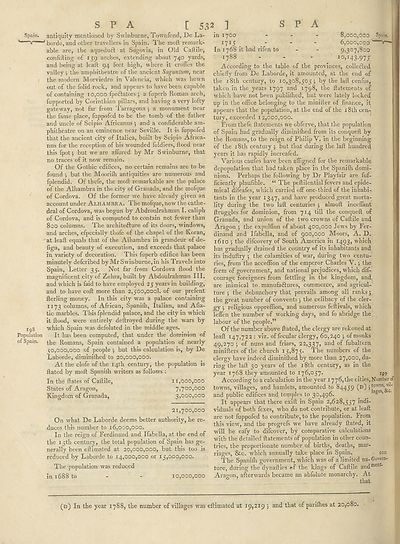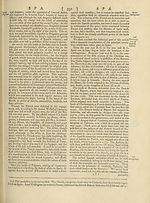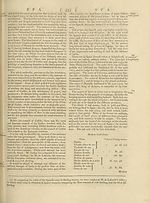Encyclopaedia Britannica, or, a Dictionary of arts, sciences, and miscellaneous literature : enlarged and improved. Illustrated with nearly six hundred engravings > Volume 19, Scripture-SUG
(580) Page 532
Download files
Complete book:
Individual page:
Thumbnail gallery: Grid view | List view

SPA
[ 532 ]
SPA
Spain, antiquity mentioned by Swinburne, Townfend, De La-
' horde, and other travellers in Spain. The moft remark¬
able are, the aqueduct at Stjgovia, in Old Caftile,
confilting of 159 arches, extending about 740 yards,
and being at lealt 94 feet high, where it croffes the
valley ; the amphitheatre of the ancient Saguntum, near
the modern Morviedro in Valencia, which was hewn
out of the folid rock, and appears to have been capable
of containing 10,000 fpeftators ; a fuperb Roman arch,
fupported by Corinthian pillars, and having a very lofty
gateway, not far from Tarragona ; a monument near
the fame place, fuppofed to be the tomb of the father
and uncle of Scipio Africanus ; and a confiderable am¬
phitheatre on an eminence near Seville. It is fuppofed
that the ancient city of Italica, built by Scipio Africa¬
nus for the reception of his wounded foldiers, flood near
this fpot 5 but we are affured by Mr Swinburne, that
no traces of it now remain.
Of the Gothic edifices, no certain remains are to be
found •, but the Moorifh antiquities are numerous and
fplendid. Of thefe, the moft remarkable are the palace
of the Alhambra in the city of Granada, and the mofque
of Cordova. Of the former wre have already given an
account under Alhambra. The mofque, now the cathe¬
dral of Cordova, was begun by Abdroulrahman I. caliph
of Cordova, and is computed to contain not fewer than
800 columns. The architecture of its doors, windows,
and arches, efpecially thofe of the chapel of the Koran,
at leaft equals that of the Alhambra in grandeur of de-
fign, and beauty of execution, and exceeds that palace
in variety of decoration. This fuperb edifice has been
minutely defcribed by Mr Swinburne, in his Travels into
Spain, Letter 35. Not far from Cordova flood the
magnificent city of Zehra, built by Abdoulrahman III.
and which is faid to have employed 25 years in building,
and to have coft more than 2,500,000!. of our prefent
fterling money. In this city was a palace containing
1173 columns, of African, Spanifli, Italian, and Afia-
tic marbles. This fplendid palace, and tire city in which
it flood, were entirely deftroyed during the wars by
i93 which Spain was defolated in the middle ages.
Population It has been computed, that under the dominion of
of Spain. tbg Romans, Spain contained a population of nearly
yo,000,000 of people ; but this calculation is, by De
Laborde, diminifhed to 20,000,000.
At the clofe of the 14th century, the population is
ftated by moft Spanifh writers as follows :
In the ftates of Caftile, 11,000,000
States of Aragon, 7,700,000
Kingdom of Granada, 3,000,000
21,700,000
On what De Laborde deems better authority, he re¬
duces this number to x6,000,000.
In the reign of Ferdinand and Ifabella, at the end of
the I 5th century, the total population of Spain has ge¬
nerally been eftimated at 20,000,000, but this too is
reduced by Laborde to 14,000,000 or 15,000,000.
The population was reduced
in 1688 to - - 10,000,000
in 1700 - . . 8,000,000 Spain.
1715 - - - 6,600,000'“ v—
In 1768 it had rifen to - - 9,307,800
1788 - - - 10,143.975
According to the table of the provinces, collected
chiefly from De Laborde, it amounted, at the end of
the 18th century, to 10,308,505; by the laft cenfus,
taken in the years 1797 and 1798, the ftatements of
which have not been publifhed, but were lately locked!
up in the office belonging to the minifter of finance, it
appears that the population, at the end of the 18th cen^
tury, exceeded 12,000,000.
From thefe ftatements we obferve, that the population
of Spain had gradually diminifhed from its conqueft by
the Romans, to the reign of Philip V. In the beginning
of the 18th century ; but that during the laft hundred
years it has rapidly increafed.
Various caufes have been affigned for the remarkable
depopulation that had taken place in the Spanifh domi¬
nions. Perhaps the following by Dr Playfair are fuf-
ficiently plaufible. “ The peftilential fevers and epide¬
mical difeafes, which carried off one-third of the inhabi¬
tants in the year 1347, and have produced great morta¬
lity during the two laft centuries ; almoft inceffant
ftruggles for dominion, from 714 till the conqueft of
Granada, and union of the two crowns of Caftile and
Aragon ; the expulfion of about 400,000 Jews by Fer¬
dinand and Ifabella, and of 900,000 Moors, A. D.
1610 ; the difcovery of South America in 1493, which
has gradually drained the country of its inhabitants and
its induftry ; the calamities of war, during two centu¬
ries, from the acceffion of the emperor Charles V. ; the
form of government, and national prejudices, which dif-
courage foreigners from fettling in the kingdom, and.
are inimical to manufactures, commerce, and agricul¬
ture ; the debauchery that prevails among all ranks ;
the great number of convents ; the celibacy of the cler¬
gy ; religious oppreffion, and numerous feftivals, which
leffen the number of working days, and fo abridge the
labour of the people.”
Of the number above ftated, the clergy are rekoned at
leaft 147,722 : viz. of fecular clergy, 60,240 ; of monks
49,270 ; of nuns and friars, 22,337, and of fubaltern
minifters of the church 15,875. The numbers of the
clergy have indeed diminiffied by more than 27,000, du¬
ring the laft 30 years of the 18th century, as in the
year 1768 they amounted to 176,057. ipp
According to a calculation in the year 1776, the cities, Number of
towns, villages, and hamlets, amounted to 84459 C-0) 3 i°V™S’g^" t
and public edifices and temples to 30,496.
It appears that there exift in Spain 2,628,557 indi¬
viduals of both fexes, who do not contribute, or at leaft
are not fuppofed to contribute, to the population. From
this view, and the progrefs we have already ftated, it
will be eafy to difcover, by comparative calculations
with the detailed ftatements of population in other coun¬
tries, the proportionate number of births, deaths, mar¬
riages, &c. which annually take place in Spain. 200
The Spanifh government, which was of a limited na-Govern-
ture, during the dynafties ef the kings of Caftile andnieIlt‘
Arason, afterwards became an abfolute monarchy. At
^ that
(d) In the year 1788, the number of villages xvas eftimated at 19,219 ; and that of pariffies at 20*080.
[ 532 ]
SPA
Spain, antiquity mentioned by Swinburne, Townfend, De La-
' horde, and other travellers in Spain. The moft remark¬
able are, the aqueduct at Stjgovia, in Old Caftile,
confilting of 159 arches, extending about 740 yards,
and being at lealt 94 feet high, where it croffes the
valley ; the amphitheatre of the ancient Saguntum, near
the modern Morviedro in Valencia, which was hewn
out of the folid rock, and appears to have been capable
of containing 10,000 fpeftators ; a fuperb Roman arch,
fupported by Corinthian pillars, and having a very lofty
gateway, not far from Tarragona ; a monument near
the fame place, fuppofed to be the tomb of the father
and uncle of Scipio Africanus ; and a confiderable am¬
phitheatre on an eminence near Seville. It is fuppofed
that the ancient city of Italica, built by Scipio Africa¬
nus for the reception of his wounded foldiers, flood near
this fpot 5 but we are affured by Mr Swinburne, that
no traces of it now remain.
Of the Gothic edifices, no certain remains are to be
found •, but the Moorifh antiquities are numerous and
fplendid. Of thefe, the moft remarkable are the palace
of the Alhambra in the city of Granada, and the mofque
of Cordova. Of the former wre have already given an
account under Alhambra. The mofque, now the cathe¬
dral of Cordova, was begun by Abdroulrahman I. caliph
of Cordova, and is computed to contain not fewer than
800 columns. The architecture of its doors, windows,
and arches, efpecially thofe of the chapel of the Koran,
at leaft equals that of the Alhambra in grandeur of de-
fign, and beauty of execution, and exceeds that palace
in variety of decoration. This fuperb edifice has been
minutely defcribed by Mr Swinburne, in his Travels into
Spain, Letter 35. Not far from Cordova flood the
magnificent city of Zehra, built by Abdoulrahman III.
and which is faid to have employed 25 years in building,
and to have coft more than 2,500,000!. of our prefent
fterling money. In this city was a palace containing
1173 columns, of African, Spanifli, Italian, and Afia-
tic marbles. This fplendid palace, and tire city in which
it flood, were entirely deftroyed during the wars by
i93 which Spain was defolated in the middle ages.
Population It has been computed, that under the dominion of
of Spain. tbg Romans, Spain contained a population of nearly
yo,000,000 of people ; but this calculation is, by De
Laborde, diminifhed to 20,000,000.
At the clofe of the 14th century, the population is
ftated by moft Spanifh writers as follows :
In the ftates of Caftile, 11,000,000
States of Aragon, 7,700,000
Kingdom of Granada, 3,000,000
21,700,000
On what De Laborde deems better authority, he re¬
duces this number to x6,000,000.
In the reign of Ferdinand and Ifabella, at the end of
the I 5th century, the total population of Spain has ge¬
nerally been eftimated at 20,000,000, but this too is
reduced by Laborde to 14,000,000 or 15,000,000.
The population was reduced
in 1688 to - - 10,000,000
in 1700 - . . 8,000,000 Spain.
1715 - - - 6,600,000'“ v—
In 1768 it had rifen to - - 9,307,800
1788 - - - 10,143.975
According to the table of the provinces, collected
chiefly from De Laborde, it amounted, at the end of
the 18th century, to 10,308,505; by the laft cenfus,
taken in the years 1797 and 1798, the ftatements of
which have not been publifhed, but were lately locked!
up in the office belonging to the minifter of finance, it
appears that the population, at the end of the 18th cen^
tury, exceeded 12,000,000.
From thefe ftatements we obferve, that the population
of Spain had gradually diminifhed from its conqueft by
the Romans, to the reign of Philip V. In the beginning
of the 18th century ; but that during the laft hundred
years it has rapidly increafed.
Various caufes have been affigned for the remarkable
depopulation that had taken place in the Spanifh domi¬
nions. Perhaps the following by Dr Playfair are fuf-
ficiently plaufible. “ The peftilential fevers and epide¬
mical difeafes, which carried off one-third of the inhabi¬
tants in the year 1347, and have produced great morta¬
lity during the two laft centuries ; almoft inceffant
ftruggles for dominion, from 714 till the conqueft of
Granada, and union of the two crowns of Caftile and
Aragon ; the expulfion of about 400,000 Jews by Fer¬
dinand and Ifabella, and of 900,000 Moors, A. D.
1610 ; the difcovery of South America in 1493, which
has gradually drained the country of its inhabitants and
its induftry ; the calamities of war, during two centu¬
ries, from the acceffion of the emperor Charles V. ; the
form of government, and national prejudices, which dif-
courage foreigners from fettling in the kingdom, and.
are inimical to manufactures, commerce, and agricul¬
ture ; the debauchery that prevails among all ranks ;
the great number of convents ; the celibacy of the cler¬
gy ; religious oppreffion, and numerous feftivals, which
leffen the number of working days, and fo abridge the
labour of the people.”
Of the number above ftated, the clergy are rekoned at
leaft 147,722 : viz. of fecular clergy, 60,240 ; of monks
49,270 ; of nuns and friars, 22,337, and of fubaltern
minifters of the church 15,875. The numbers of the
clergy have indeed diminiffied by more than 27,000, du¬
ring the laft 30 years of the 18th century, as in the
year 1768 they amounted to 176,057. ipp
According to a calculation in the year 1776, the cities, Number of
towns, villages, and hamlets, amounted to 84459 C-0) 3 i°V™S’g^" t
and public edifices and temples to 30,496.
It appears that there exift in Spain 2,628,557 indi¬
viduals of both fexes, who do not contribute, or at leaft
are not fuppofed to contribute, to the population. From
this view, and the progrefs we have already ftated, it
will be eafy to difcover, by comparative calculations
with the detailed ftatements of population in other coun¬
tries, the proportionate number of births, deaths, mar¬
riages, &c. which annually take place in Spain. 200
The Spanifh government, which was of a limited na-Govern-
ture, during the dynafties ef the kings of Caftile andnieIlt‘
Arason, afterwards became an abfolute monarchy. At
^ that
(d) In the year 1788, the number of villages xvas eftimated at 19,219 ; and that of pariffies at 20*080.
Set display mode to:
![]() Universal Viewer |
Universal Viewer | ![]() Mirador |
Large image | Transcription
Mirador |
Large image | Transcription
Images and transcriptions on this page, including medium image downloads, may be used under the Creative Commons Attribution 4.0 International Licence unless otherwise stated. ![]()
| Permanent URL | https://digital.nls.uk/192702822 |
|---|
| Attribution and copyright: |
|
|---|
| Description | Ten editions of 'Encyclopaedia Britannica', issued from 1768-1903, in 231 volumes. Originally issued in 100 weekly parts (3 volumes) between 1768 and 1771 by publishers: Colin Macfarquhar and Andrew Bell (Edinburgh); editor: William Smellie: engraver: Andrew Bell. Expanded editions in the 19th century featured more volumes and contributions from leading experts in their fields. Managed and published in Edinburgh up to the 9th edition (25 volumes, from 1875-1889); the 10th edition (1902-1903) re-issued the 9th edition, with 11 supplementary volumes. |
|---|---|
| Additional NLS resources: |
|

